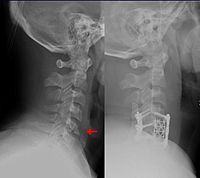
Photo from wikipedia
BACKGROUND Active opioid users experience more pain and require more opioids after primary shoulder arthroplasty than non-opioid users. However, it is unknown whether discharge prescription regimens are tailored to these… Click to show full abstract
BACKGROUND Active opioid users experience more pain and require more opioids after primary shoulder arthroplasty than non-opioid users. However, it is unknown whether discharge prescription regimens are tailored to these different postoperative opioid requirements. METHODS We performed a retrospective analysis of a prospectively collected cohort of patients who underwent primary shoulder replacement over a 15-month period. Demographic and operative variables were collected and compared between prior opioid users and non-opioid users. Inpatient opioid requirements, daily discharge prescription regimens, total prescription quantities, and rates of persistent opioid use 6 weeks after surgery were also compared between these cohorts. RESULTS A total of 119 patients were analyzed (mean age, 68 years; 53% men; 39.5% prior opioid users). Prior opioid users required considerably more opioids on the first (60 oral morphine equivalents [OMEs] vs 45 OMEs, P = .01) and last (42 OMEs vs 15 OMEs, P < .001) hospitalization days but were discharged with similar daily opioid regimens (90 OMEs vs 90 OMEs, P = .3), total opioid quantities (600 OMEs vs 600 OMEs, P = .24), and total pills (80 vs 60, P = .27) compared with non-opioid users. Persistent opioid use 6 weeks after surgery was 7-fold higher for prior opioid users than nonusers (71.0% vs 9.1%, P < .001). CONCLUSIONS Daily and total opioid regimens prescribed after primary shoulder arthroplasty were similar between prior opioid users and nonusers despite large differences in their inpatient opioid requirements. Tailoring discharge opioid prescription regimens to inpatient use appears feasible and warrants further study.
Journal Title: Journal of shoulder and elbow surgery
Year Published: 2018
Link to full text (if available)
Share on Social Media: Sign Up to like & get
recommendations!